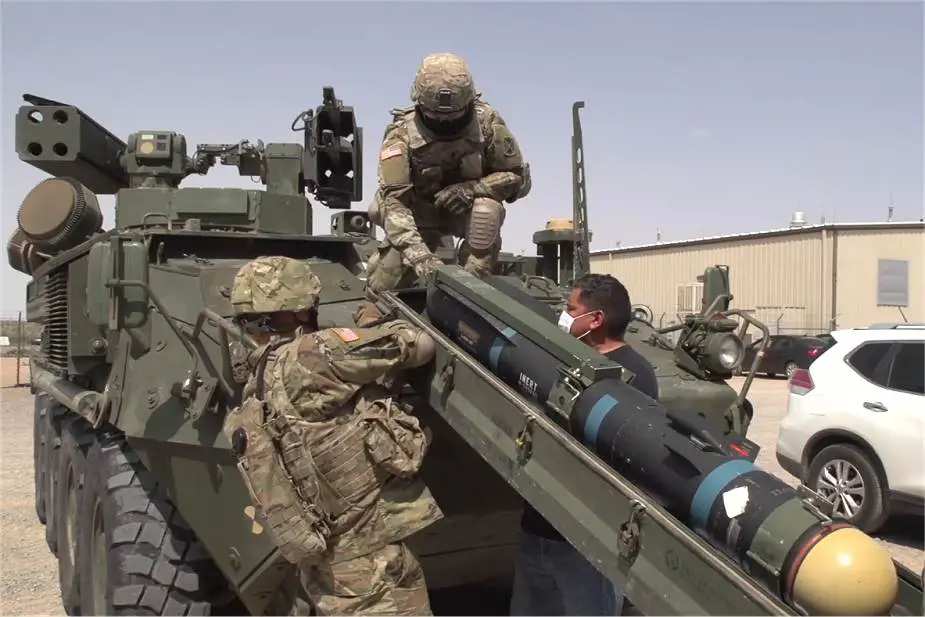According to information published by the U.S. Army on November 18, 2020, U.S. soldiers from the 5th Battalion, 4th Air Defense Artillery Regiment out of Ansbach, Germany are on WSMR (White Sands Missile Range) conduction training and operational testing of the U.S. Army’s Initial Maneuver Short Range Air Defense (IM-SHORAD) system.
Follow Army Recognition on Google News at this link

U.S. soldiers conducting training and operational testing on the Initial Maneuver Short Range Air Defense (IM-SHORAD) system, including loading, and sighting the system. (Picture source U.S. DoD)
The IM-SHORAD (Initial Maneuver Short Range Air Defense) system is one of the U.S. Army’s solutions to replace the aging Avenger short-range air defense system. While the Avenger worked well in its day as a Cold War platform for the protection of Army units from close in air threats, the system is showing its age, being less survivable than other modern air defense systems, and requiring a long set up time to get operational. The IM-SHORAD is built to bring a modernized package of capabilities to the table and improve in the areas the Avenger struggles. Mounted on a Stryker armored vehicle, IM-SHORAD can keep up with the units they are protecting, with better armor and survivability than a HUMVEE platform provides. The system has its own radar, and an array of weapons that can be effective against air threats without a long setup process.
The Stryker A1 IM-SHORAD unveiled by the American Company General Dynamics Land Systems (GDLS) is fitted with a turret armed with Longbow Hellfire and Stinger missiles launchers. The AGM-114L Longbow Hellfire is the latest Hellfire derivate featuring a millimeter-wave guidance system and fire-and-forget capability. The Longbow Hellfire was designed to be launched from the radar-equipped AH-64D Longbow Apache attack helicopter increasing its survivability thanks to its fire-and-forget capability. The Stinger is a surface-to-air missile, it has an outward targeting range of up to 4,800 m (15,700 feet) and can engage low altitude enemy threats at up to 3,800 m (12,500 feet).
The second armament of the turret includes one XM914 30 mm automatic cannon and one 7.62 mm coaxial machine gun. With all these weapons the vehicle is able to destroy unmanned aerial systems as well as fixed-wing and rotary-wing threats.
At this time the IM-SHORAD system is not quite ready for full production, but multiple prototypes have been made. To get the system ready to be mass-produced, operational testing is needed. Soldiers need to get their hands on the system, learn to use it, and then use it just as they would, including trying new things, making mistakes, and otherwise doing the sort of thing that the system designers may not have prepared for.
While the system has been doing plenty of developmental testing on WSMR this pivot to operation testing is an important step. Without a full battery of operational tests, the system could be delivered to the Soldier with bugs and technical issues that can’t be found through developmental testing by engineers who are intimately familiar with all the technical and operational details of the system.
Bringing in a unit from Germany to just conduct operational testing may seem a little extreme, but for the long-term, it’s an advantageous decision. First, the unit is already equipped with the Avenger system the IM-SHORAD system is set to replace. This means that the Soldiers giving their feedback and testing the system will have a solid base for comparison, making them perfect for not just evaluating the differences, but also giving them the ability to really test the system to the mission it’ll be expected to perform, and treat the system exactly how it will be treated by the end-user.
Secondly, the 5-4 ADA is currently set to be the first unit to receive the IM-SHORAD system. By getting their hands on the system in advance, the unit is ensuring that when the finalized vehicle is delivered, there will already be a core cadre of Soldiers that are fully trained on the system and familiar with its abilities, quirks, and unique features. This should make training up soldiers new to the system a little easier, as their peers can directly contribute to the training and provide nuance that can only be gotten in a Soldier-to-Soldier training environment.
While the future of the IM-SHORAD system is bright; for now, testing continues, running the Soldiers through every system, setting, and operation of the IM-SHORAD. The final delivery of the system to Germany is currently scheduled for early next year.














